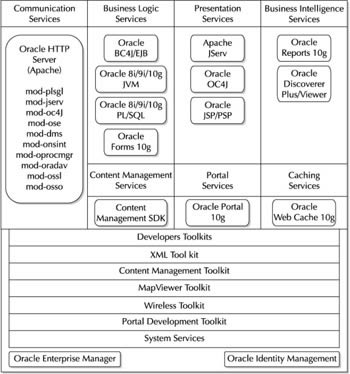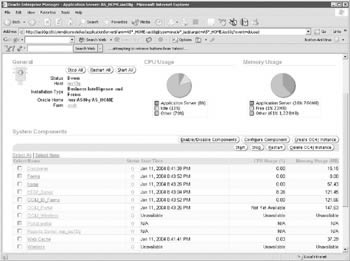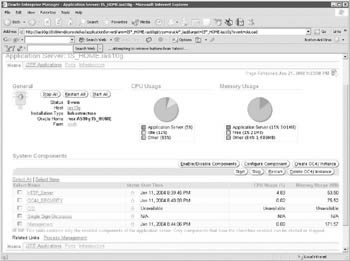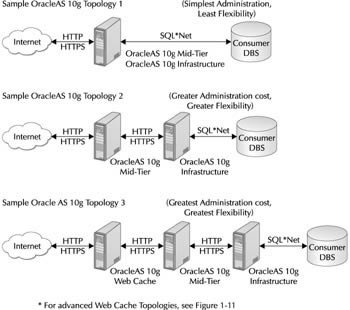What Is Oracle Application Server 10g?
| | ||
| |
What Is Oracle Application Server 10 g ?
Oracle Application Server 10 g is an application server designed to support all major web development languages and frameworks. It is a collection of services designed together to integrate seamlessly with Oracle databases and deliver content dynamically over the Web. Some of its features include:
-
Oracle HTTP Server Application Server 10 g includes an HTTP server based on the Apache HTTP Server, version 1.3.28. The Apache server is the most popular web server in use today. It is highly customizable and its architecture fully supports enhancements via modules.
-
Oracle Portal Portal is a complete, web-based development environment that allows you to develop and implement production-quality applications quickly and easily.
-
Oracle Wireless Wireless provides complete support for enabling your applications on a multitude of wireless devices.
-
Oracle Identity Management Identity Management has security features that can be applied across all types of applications served up by Application Server 10 g.
-
PL/SQL integration Procedural Language extension to Structured Query Language (PL/SQL) integration gives you the ability to call PL/SQL stored procedures directly from your HTML-based applications via the PL/SQL Web Toolkit and the mod_plsql module included with Apache.
-
Oracle Forms, Oracle Reports , and Oracle Discoverer Servers These servers give you the ability to serve Forms, Reports and Discoverer workbooks and worksheets over the Web and integrate those components with Portal.
On top of all of these features, Application Server 10 g also supports the full Java 2 Enterprise Edition technology stack, including:
-
Enterprise JavaBeans (EJBs) EJBs enable applications to use entity, session, and message-driven beans. They come with an EJB container that provides services for you. Services include transaction, persistence, and lifecycle management.
-
Servlets Servlets can generate dynamic responses to web requests .
-
JavaServer Pages (JSP) Enable you to mix Java and HTML to author web applications easily. JSP also enable you to generate dynamic responses to Web requests. Servlets and JSP run within a web container, which also provides services similar to those provided by the EJB container.
-
Java Authentication and Authorization Service (JAAS) JAAS enables you to authenticate users (ensures that users are who they claim to be) and authorizes users (checks that users have access to an object before executing or returning the object).
-
Java Message Service (JMS) JMS enables you to send and receive data and events asynchronously.
-
Java Transaction API (JTA) JTA enables your applications to participate in distributed transactions and access transaction services from other components.
-
J2EE Connector Architecture The J2EE Connector Architecture enables you to connect and perform operations on enterprise information systems.
Out of the box, Application Server 10g also includes various programs and web pages for the administration of this complex environment. The Enterprise Manager Application Server Control provides numerous pages for monitoring the various services in Application Server 10g and gives administrators the ability to edit configuration files and review log files via a web browser. This is invaluable for remote administration of application server instances when it is difficult to provide direct access to a server and simplifies the administrator s job by not having to make them remember the file names and directory paths of the many log and configuration files used by Application Server 10 g . Certain configuration editor pages even have syntax checking functionality built into them, allowing administrators to verify their changes before attempting to implement modifications to components on the Server. Most of the tasks that can be performed on these pages are administrative and are of little interest to the developer, but, as we ll see in later chapters, there are pages devoted to the creation and maintenance of containers, which give developers the ability to deploy their applications quickly and easily through a graphical interface.
The power of Application Server 10 g lies in its seamless integration with various Internet and programmatic standards and the Oracle database. It has evolved into a product that enables you and your organization to benefit from the true power of the Internet by providing a reliable, scalable, and secure deployment platform. Figure 1-1 provides a visual representation of the Application Server 10 g product.

Figure 1-1: Oracle Application Server 10g Architecture
The boxes at the top of each section represent the different categories of services. The ovals represent Oracle s implementation of those services. This chapter discusses, at a high level, the various services that Application Server 10 g provides and why you, as a developer, are interested in them. Chapter 2 discusses Oracle s implementation of these services in detail. The architecture of Application Server 10 g may seem overly complex, but this is necessary as it reflects Oracle s commitment to the numerous open standards and frameworks that constitute modern web development. The architecture also gives Application Server 10 g a level of scalability and reliability not seen in most application servers.
There are two major pieces of Application Server 10 g : the middle tier , which provides components for deploying and running applications over the Web, and the infrastructure, which maintains security and clustering information. In a one-to-many relationship, a single infrastructure can maintain security and clustering information for one or many middle tiers. When you install Application Server 10 g , you must decide if you ll need an infrastructure because that piece needs to be installed first. We cover the different types of middle-tier installations, and if they are dependent on an infrastructure, next .
What is an infrastructure and a middle tier composed of? Each piece is composed of a series of programs, which provide various services to the Apache server. As an analogy, think of the services that run on a Windows machine ”they are programs that provide various services to the operating system. In the same way, the programs that constitute the infrastructure and middle tiers provide services to the Application Server instance. The middle tier has three different versions that you can install, depending on your needs and licensing:
-
J2EE and Web Cache
-
Portal and Wireless
-
Business Intelligence and Forms
Table 1-1 lists the different middle-tier components of Application Server 10 g configured with each type of installation.
| Component | J2EE and Web Cache | Portal and Wireless | Business Intelligence and Forms |
|---|---|---|---|
| Oracle HTTP Server | X | X | X |
| Oracle Application Server Containers for J2EE (OC4J) | X | X | X |
| Oracle Application Server Web Cache | X | X | X |
| Oracle Enterprise Manager web site | X | X | X |
| Oracle Application Server TopLink | X | X | X |
| Oracle Application Server Portal | X | X | |
| Oracle Application Server Wireless | X | X | |
| Oracle Application Server Personalization | X | ||
| Oracle Application Server Discoverer | X | ||
| Oracle Application Server Reports Services | X | ||
| Oracle Application Server Forms Services | X |
Based on this table, if you plan to serve Oracle Forms, Oracle Reports, and/or Oracle Discoverer workbooks and worksheets over the Web, install the Business Intelligence and Forms option. If you want to use Portal and/or develop applications to be used with wireless (handheld) devices, select the Portal and Wireless option. If you only need a web server to deploy J2EE applications, select the J2EE and Web Cache option. When you install the middle tier, you are creating an Oracle Application Server instance.
The meaning of the word instance in this context is different from the more general use of instance, which is commonly used to refer to an Oracle database instance. Figure 1-2 shows the administration page with all of the services for a middle tier installed with the Business Intelligence and Forms option.

Figure 1-2: A Middle-tier administration screen
As of version 8.1.7 of the Oracle database server, Oracle includes an HTTP server as part of its installation. It provides only the first two components in Table 1-1: an HTTP server and Oracle Application Server Containers for J2EE (OC4J) containers.
The second major piece of Application Server 10 g is called the infrastructure . The infrastructure is an instance of Application Server 10 g that maintains security and clustering information. In Oracle s documentation, the different types of security components provided by Oracle are called Identity Management. The Identity Management components provide directory, security, and user management functionality. The Identity Management components are
-
Oracle Internet Directory
-
Oracle Application Server Single Sign-On
-
Oracle Delegated Administration Services
-
Oracle Directory Integration and Provisioning
-
Oracle Application Server Certificate Authority
Each of the Identity Management components are discussed in Chapter 2. For both the Business Intelligence and Forms option and the Portal and Wireless option, an infrastructure is required. The infrastructure, by default, uses an Oracle 9 i Database to store Identity Management information, but an Oracle9 i or Oracle Database 10 g can be manually specified. The Identity Management information is referenced through a Lightweight Directory Access Protocol (LDAP) server provided by Oracle called Oracle Internet Directory (OID). You can instruct the installer to use an existing Oracle9 i Database or Oracle Database10 g instance or have the installer create a new database instance for you. Figure 1-3 shows the administration page with all of the services for an infrastructure.

Figure 1-3: Administration screen for the infrastructure
Technically, the Forms and Reports servers can be configured to not use an infrastructure in Application Server 10 g , but it is far more common to use one.
Topology describes the layout of Application Server 10 g instances installed in your organization. Application Server 10 g can be installed in so many different ways that there is an entire chapter on it, entitled Recommended Topologies, in the installation guide. The most common topology is to install the infrastructure on one machine and the middle tier on another, although you can install both the infrastructure and middle tier on the same machine, provided you have enough disk and memory resources (as each instance needs to be installed in its own ORACLE_HOME), or numerous middle tiers on numerous servers. Figure 1-4 lists some common topologies. In an effort to provide organizations with a high amount of flexibility, the infrastructure and middle tiers do not have to be running on the same hardware or operating system platform. They do, however, have to be running the same version of the Oracle Application Server 10 g software.

Figure 1-4: Common topologies
Since all instances must be running the same version of the software, this means that any patch applied to an Oracle Application Server 10 g instance must be applied to all instances, even if they re running on the same machine.
The different categories of the Application Server architecture (see Figure 1-1) discussed in this chapter are grouped according to the type of function they provide:
-
Communication Services These services handle requests to and from the Web.
-
Business Logic Services These services are the development tools and languagesfor building applications.
-
Presentation Services These service are the development tools and languages for building dynamic web pages.
-
Caching Services These services are tools for improving web site performance.
-
Content Management Service s These services are tools for managing documents in the database.
-
Portal Services These services provide publishing features for content and portlets.
-
Business Intelligence Services These services provide reports and ad-hoc queries.
-
Database Services These services make up the Oracle database for storing application data.
-
Persistence Layer Services These services provide an object-relational framework.
-
Developer s Toolkits APIs to aid in the creation of applications.
| | ||
| |
EAN: 2147483647
Pages: 192